January 2019
Help is on its way!
The plan to protect the Brush-tailed Rock-wallaby
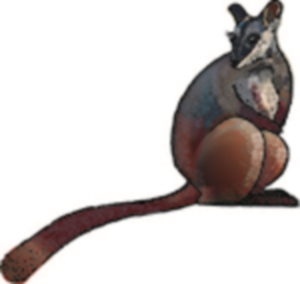
The ACT Government recently announced that the Southern Brush-tailed Rock-wallaby (Petrogale penicillata) would be the new Mammal Emblem for the Australian Capital Territory. A public survey was held and a tightly run race ensued, pitching hot favourite Brian the Bettong against Rhonda the Rock-wallaby. Nose to nose up to the last minute, Rhonda took out the prize by a mere forty votes.
But why was this particular wallaby considered? What do we know about its history in our region? And when was it classified as endangered? In our annual release of records ArchivesACT identified a shift in government policy when in October 1997 new measures were announced to protect our local endangered species, including grasslands, mammals, insects and this little local wallaby.
Public interest in our mammal emblem, the efforts of the ACT Parks and Conservation Service and the release of the 1997 records on the Southern Brush-tailed Rock-wallaby make this good news story perfect as ArchivesACT’s January Find of the Month.
On the wallaby trail
The term ‘rock wallaby’ comes from the Eora word ‘wulaba’. The wallaby was traditionally a source of food and furs and is documented in aboriginal rock engravings in the Eora region dating back as far as 5,000 years. Wallabies feature in stories from the dreamtime, and in more recent Australian folk history. The phrase ‘on the wallaby’ was adapted from the use of wallaby tracks as a travelling route, and means to ‘travel across country’. Poet Henry Lawson used the term in his poem ‘Freedom on the Wallaby’ which spoke of the struggles of the Australian shearer in 1891 to fight for workers rights.
Wallabies are macropods and around thirty species still exist across Australia. Several of these are endangered, despite their prolific ability to breed. Wallabies are easy prey for eagles, foxes and feral cats, they face environmental disasters such as bushfires and drought, must fight for territory with wild goats, and compete for food with both kangaroos and introduced livestock. The smaller the wallaby, the higher the risk, and Brush-tailed Rock-wallabies are amongst the smallest species at only 5-8kg.
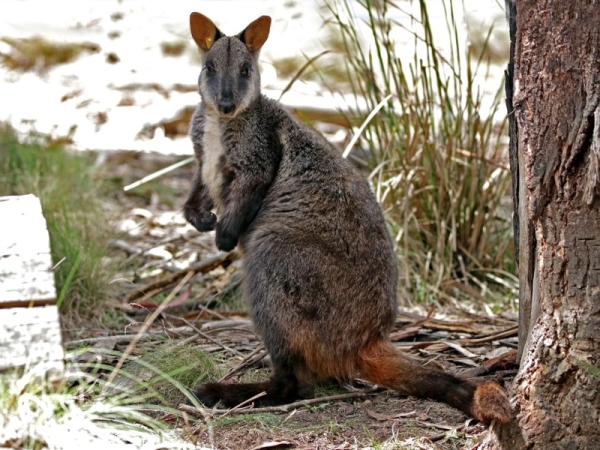
Source: Canberra Nature Map
Whilst local aborigines hunted the wallaby for food, it was the introduction of hunting for sport by European settlers that would prove the most damaging. Wallabies were for many years the subject of sport on a scale which might seem inconceivable today, as hunters vied to bag as many animals as possible. Wallaby drives, as they were called, were often reported in the local papers as social occasions where a host would provide a meeting place for a shooting party followed by a sumptuous meal. The following excerpt was taken from an article in the Queanbeyan Age dated 1875:
Wallabies, a smaller species of kangaroo, are more generally shot after the manner of rabbit shooting; but as their habitat is generally on rocky mountain heights, the sport is much more hazardous and fatiguing. The average shooting is from 30 to 40 skins per day and parties of six or eight frequently return with 1000 skins and upwards as the result of a few days' shooting.
Even after legislation was introduced to control the hunting of native animals these laws were rarely policed, or, as one trapper noted in 1932 “…but where was the law yet that even a fool driver couldn’t put his team, waggon [sic], and all through?”
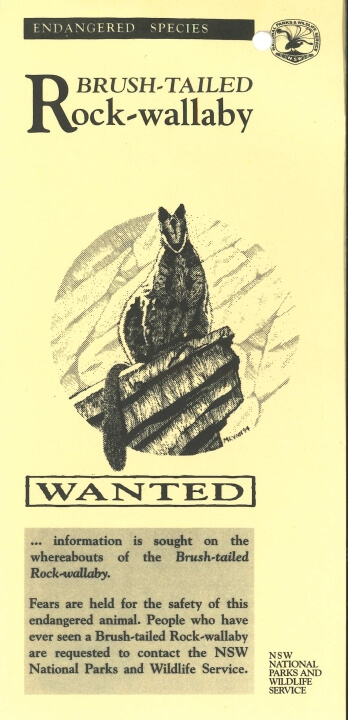
Brochure produced by the NSW National Parks and Wildlife Service c1992 (Source: 94/19081)
This land is your land
The Brush-tailed Rock-wallaby has a long connection with south eastern Australia, although it has been steadily in decline in the last century. Small colonies still exist in the wild in steep rocky country areas such as the upper Snowy River area of East Gippsland, the Grampians and, closer to home, Kangaroo Valley. By the 1950s, these wallabies were rarely sighted in the ACT, and concerned staff at Tidbinbilla developed their first conservation plan in the 1960s, and started a breeding program in the 1980s.
By 1992 it was suspected that these wallabies may be extinct in the ACT, and studies showed that whole colonies were disappearing in the other two states. The Australian Alps Liaison Committee developed a project to work with all three states to prevent the extinction of the species in south eastern Australia. Among a number goals, the committee planned to establish captive colonies for displaced animals as an effort to conserve and boost populations into the future. The biggest challenge would be solving the problem of breeding enough young as quickly as possible for release into the wild.
At this time Tidbinbilla was caring for seven wallabies, all of which were highly inbred. Although they had already acquired animals from the Healesville Sanctuary in Victoria, their priority was to acquire additional animals from New Zealand, or from the wild if possible. By 1999 Tidbinbilla had found a solution to speed up the rock wallaby breeding rate:
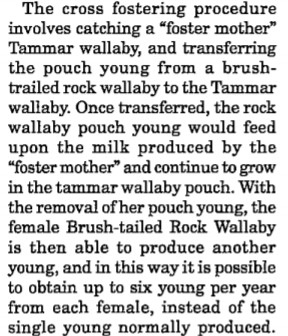
Excerpt from the bulletin of the National Parks Association of the ACT (Source: 94/19081)
This local ingenuity has seen Tidbinbilla become a leader in reproductive biology. Tidbinbilla staff have now successfully produced more than 70 joeys, some of which have been reintroduced to the wild as part of the ACT Government’s ongoing collaboration with the other states..
Too cool for scats
In October 1995 staff at the ACT Parks and Conservation's Wildlife Research Unit received some reported sightings of rock-wallabies in the Namadgi National Park. When a new sighting on Mt Orroral was reported, the staff whacked on their walking boots and set off to see what they could find. The following photos were taken of their expedition:
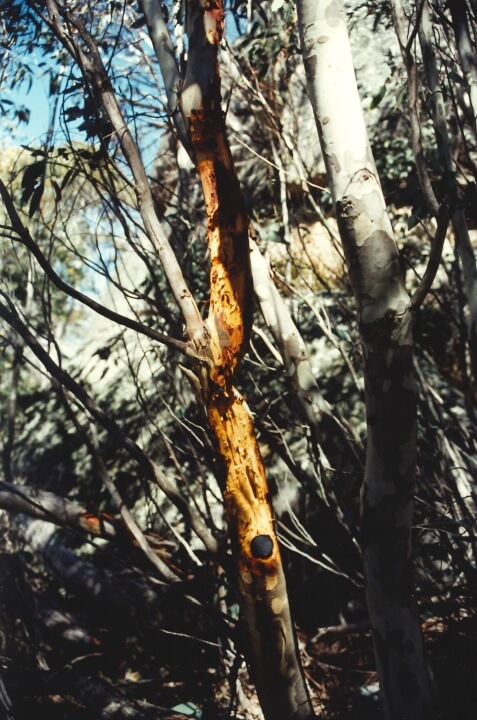
Yellow tailed black cockatoo damage - Mt Orroral 13 Oct 1995 (Source: 94/19081)
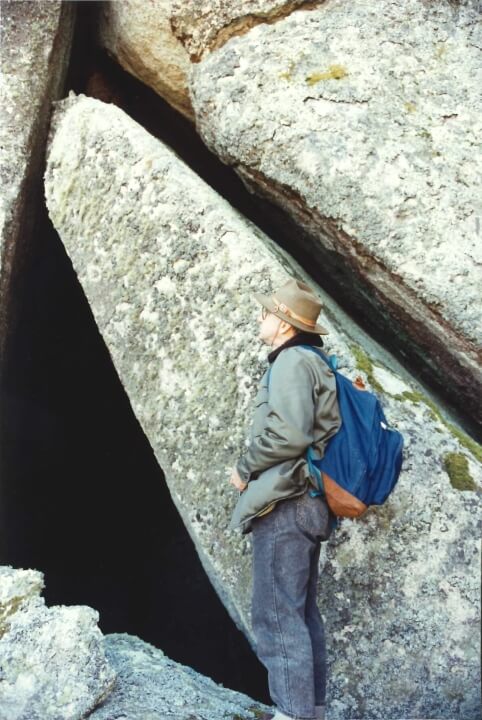
Rock-wallaby evidence search - Mt Orroral 13 Oct 1995 (Source: 94/19081)
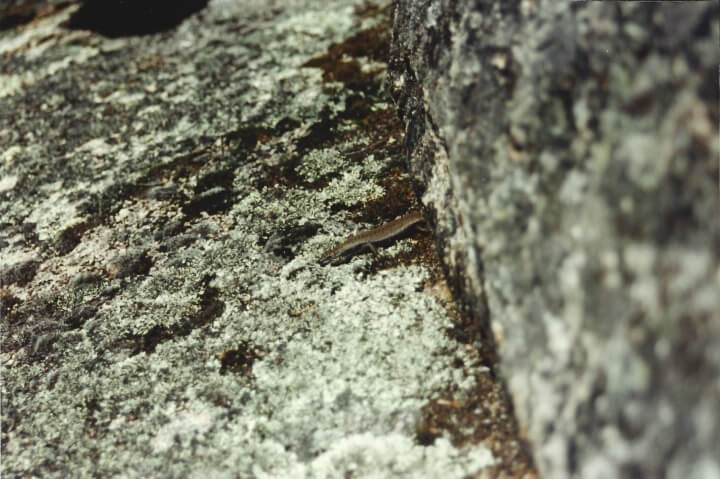
Friendly local - Mt Orroral 13 Oct 1995 (Source: 94/19081)
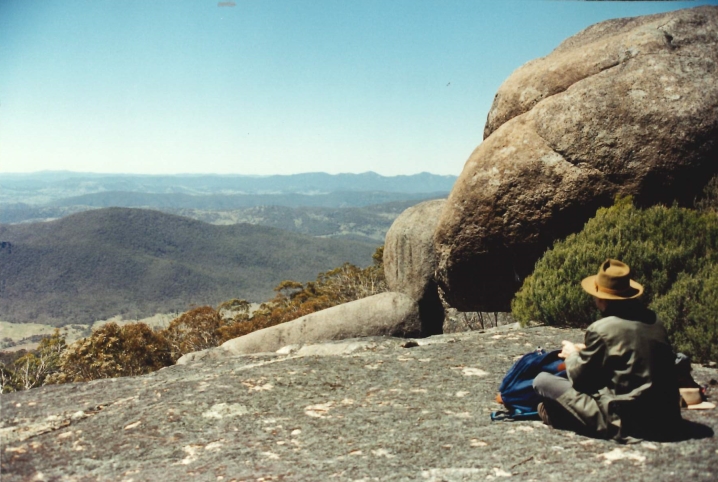
Time for lunch - Mt Orroral 13 Oct 1995 (Source: 94/19081)
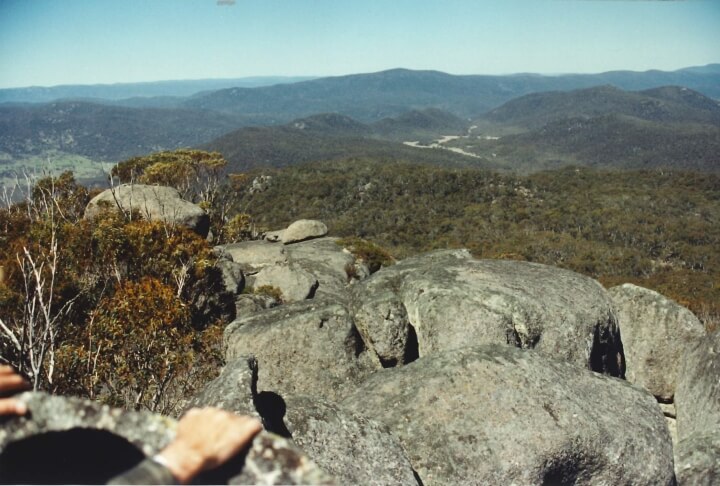
Scouring the top - Mt Orroral 13 Oct 1995 (Source: 94/19081)
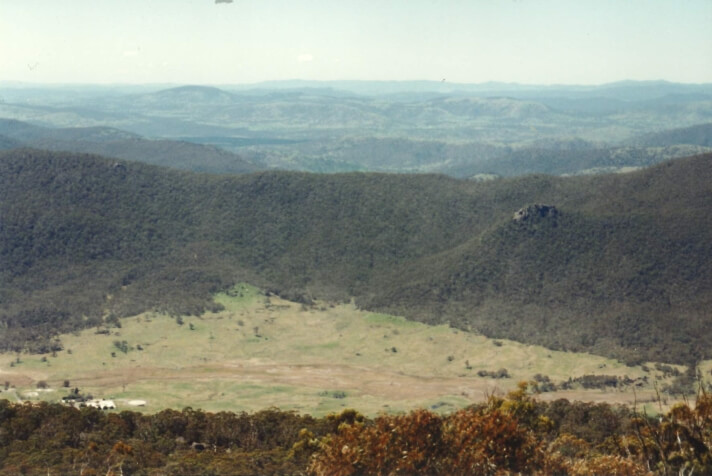
Orroral Valley 13 Oct 1995 (Source: 94/19081)
Unfortunately the elusive wallaby was nowhere to be found, and predator scats collected by staff and sent away for testing also came out negative. Unconfirmed sightings continued to come in however, and so the staff continued to collect and test scats to look for evidence. Finally in October 1995 scats collected on the Cypress Pine Walking Track came back positive for Rock-wallaby, giving credence to the sightings, and rumours persist to this day that a small colony still resides in the park.
Protecting our most vulnerable locals
In October 1997, the ACT Government announced new measures to ensure the greatest chance of survival for local endangered species including native grassland, and threatened plants and animals. Determined to sustain the ACT’s biodiversity, the government developed and released draft action plans for comment. These plans included protection of our most vulnerable species, including the Southern Brush-tailed Rock-wallaby. The government gave increased attention to a species review and, based on the recommendations of the ACT Flora and Fauna Committee, a number of species were named as either vulnerable or endangered.
Vulnerable | Endangered |
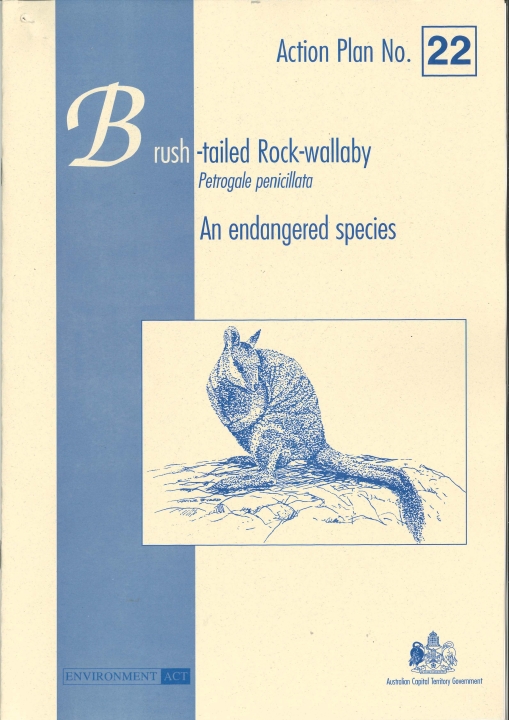
The Southern Brush-tailed Rock-wallaby was once commonly found in our region. Thanks to the efforts of our own ACT Parks and Conservation staff and their colleagues in the Commonwealth, Victorian and New South Wales governments, we hope one day to see the Rock-wallaby reintroduced into the wild in the ACT.
If you are walking through our parks and reserves you might like to keep an eye out for a real life example of our new mammal emblem. Some tips? Rock-wallabies are notoriously shy, small, and predominately brown with long dark tails with brushes at their tip. They inhabit steep rocky areas with lots of overhanging ledges or caves and prefer a north facing arrangement, not unlike the savvy Canberran house seeker! They feed at dusk and spend their days close to their homes, socialising, grooming and soaking up the sun.
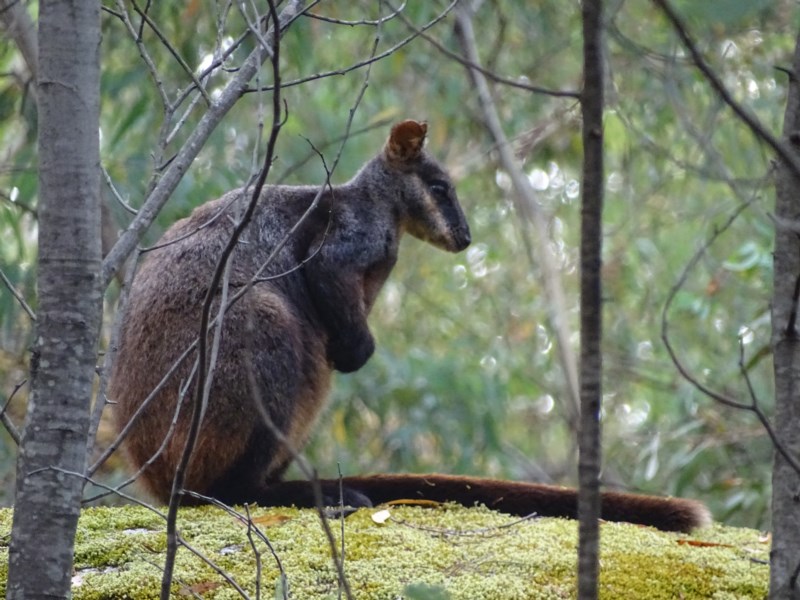
Source: Canberra Nature Map (Contributor: RoyMCD 2016)
Happy New Year Canberra! Have you been out to visit Tidbinbilla recently?
Have you taken a walk through Namadgi National Park?
Why not tweet about it and don’t forget to include @ArchivesACT.

Ready to start your own research?
Contact us through our Request a Record service and we will be happy to help.
Files
Links to News Articles
CHAPTER II. (1875, August 7). Queanbeyan Age (NSW : 1867 - 1904), p. 4. Retrieved December 20, 2018, from http://nla.gov.au/nla.news-article30598774
No Title (1883, July 20). Queanbeyan Age (NSW : 1867 - 1904), p. 3. Retrieved December 20, 2018, from http://nla.gov.au/nla.news-article30788261
Southern rock-wallaby edges out Bettong in mammal emblem poll (2018, July 31), The Canberra Times. Retrieved December 19, 2018 from: https://www.canberratimes.com.au/politics/act/southern-rock-wallaby-edges-out-bettong-in-mammal-emblem-poll-20180731-p4zukw.html
THE TRAPPER FROM THE HILLS (1932, December 22). The Canberra Times (ACT : 1926 - 1995), p. 4. Retrieved December 20, 2018, from http://nla.gov.au/nla.news-article2325712
Photo Credits
Canberra Nature Map (2017). Petrogale penicillata. Retrieved from: https://canberra.naturemapr.org/Community/CategoryGuide/79
Canberra Nature Map, Contributor: RoyMCD (2016) Petrogale penicillata. Retrieved from: https://canberra.naturemapr.org/Community/CategoryGuide/79
Links to ACT Government Websites
ACT Flags and Emblems - Chief Minister, Treasury and Economic Development Directorate: https://www.cmtedd.act.gov.au/communication/flags
Conservation and ecological communities, threatened species action plans - Environment, Planning and Sustainable Development Directorate: https://www.environment.act.gov.au/cpr/conservation_and_ecological_communities/threatened_species_action_plans
Endangered species breeding program - Tidbinbilla: https://www.tidbinbilla.act.gov.au/learn/tidbinbilla/endangered-species-breeding-programs
Parks and Reserves - Environment, Planning and Sustainable Development Directorate: https://www.environment.act.gov.au/parks-conservation/parks-and-reserves
Links to External Websites
Australian animals yellow footed rock wallaby - Tourism Australia: https://www.australia.com/en/things-to-do/nature-and-wildlife/australian-animals-yellow-footed-rock-wallaby.html
Bulletin of the National Parks Association of the ACT (1999): http://www.npaact.org.au/res/File/Bulletins2/Vol%2036%20No%201%20Mar%201999%20A.pdf
Freedom on the wallaby - Wikipedia: https://en.wikipedia.org/wiki/Freedom_on_the_Wallaby
Friends of the Brush-tailed Rock-wallaby: https://www.rockwallaby.org.au/
Meanings and origins of Australian words and idioms - ANU: http://slll.cass.anu.edu.au/centres/andc/meanings-origins/o
Moore Park Engraving - Barani: http://www.sydneybarani.com.au/sites/moore-park-engraving/
The story of the two sisters - Goolarabooloo: http://www.goolarabooloo.org.au/dreamtime.html
Previous Find of the Month
2008 2009 2010 2011 2012 2013 2014 2015 2016 2017 2018 2019
File Readers/Viewers
If you do not already have compatible software on your computer, free file readers/viewers can be downloaded from the following links.
 PDF files require Adobe Acrobat Reader
PDF files require Adobe Acrobat Reader PPS files require Microsoft PowerPoint Viewer
PPS files require Microsoft PowerPoint Viewer XLS files require Microsoft Excel Viewer
XLS files require Microsoft Excel Viewer
